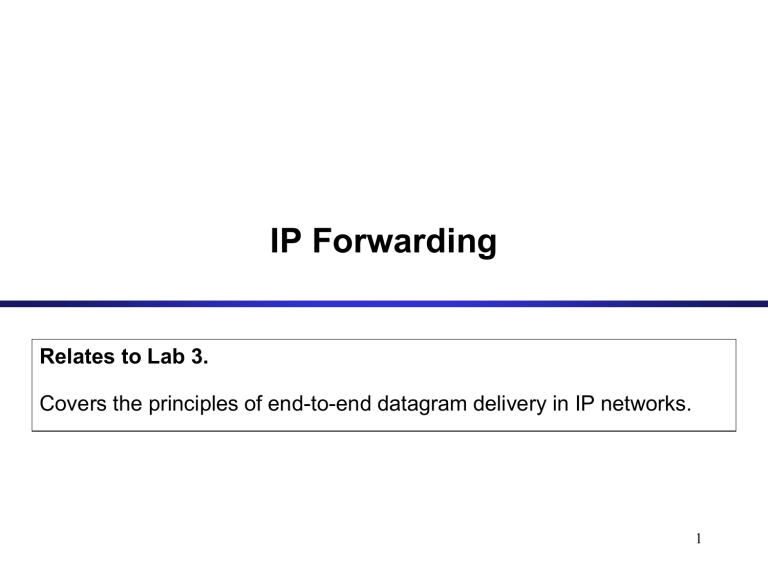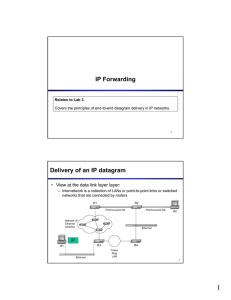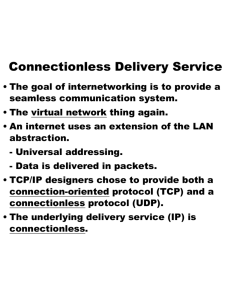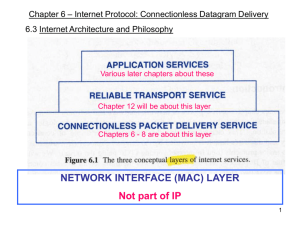IP Forwarding

IP Forwarding
Relates to Lab 3.
Covers the principles of end-to-end datagram delivery in IP networks.
1
Orientation
• Internet is a collection of networks
• IP provides an end-to-end delivery service for IP datagrams between hosts
• The delivery service is realized with the help of IP routers
2
Delivery of an IP datagram
• View at the data link layer layer:
– Internetwork is a collection of LANs or point-to-point links or switched networks that are connected by routers
R1 R2
Point-to-point link Point-to-point link
H2
Network of
Ethernet switches
Ethernet
IP
R3 R4
H1
Token
Ring
LAN
Ethernet
3
Delivery of an IP datagram
• View at the IP layer:
– An IP network is a logical entity with a network number
– We represent an IP network as a “ cloud ”
– The IP delivery service takes the view of clouds, and ignores the data link layer view
R1 R2
10.2.1.0/24 20.2.1.0/28
H2
10.1.2.0/24 20.1.0.0/16
IP
10.1.0.0/24 10.3.0.0/16
H1
R3 R4
4
Tenets of end-to-end delivery of datagrams
The following conditions must hold so that an IP datagram can be successfully delivered
1. The network prefix of an IP destination address must correspond to a unique data link layer network (=LAN or point-to-point link or switched network).
2. Routers and hosts that have a common network prefix must be able to exchange IP datagrams using a data link protocol (e.g., Ethernet, PPP)
3. An IP network is formed when a data link layer network is connected to at least one other data link layer network via a router.
5
Routing tables
• Each router and each host keeps a routing table which tells the router how to process an outgoing packet
• Main columns:
1.
Destination address: where is the IP datagram going to?
2.
Next hop or interface: how to send the IP datagram?
• Routing tables are set so that a datagram gets closer to the its destination
Destination Next Hop
Routing table of a host or router
IP datagrams can be directly delivered
(
“ direct
”
) or are sent to a next hop router (
“
R4
”
)
20.2.1.0/28
10.1.0.0/24
10.1.2.0/24
10.2.1.0/24
10.3.1.0/24
20.1.0.0/16
R4 direct direct
R4 direct
R4
6
Delivery with routing tables
Destination Next Hop
10.1.0.0/24 R3
10.1.2.0/24
10.2.1.0/24
10.3.1.0/24
20.2.0.0/16
30.1.1.0/28 direct direct
R3
R2
R2
R1
10.2.1.0/24
Destination Next Hop
10.1.0.0/24
10.1.2.0/24
10.2.1.0/24
10.3.1.0/24
20.1.0.0/16
20.2.1.0/28
R1
R1 direct
R4 direct direct
R2
20.2.1.0/28
Destination Next Hop
10.1.0.0/24
10.1.2.0/24
10.2.1.0/24
10.3.1.0/24
20.1.0.0/16
20.2.1.0/28
R2
R2
R2
R2
R2 direct
H2
20.2.1.2/28
10.1.2.0/24 to:
20.2.1.2
H1
Destination Next Hop
10.1.0.0/24
10.1.2.0/24
10.2.1.0/24
10.3.1.0/24
20.1.0.0/16
20.2.1.0/28 direct
R3
R3
R3
R3
R3
10.1.0.0/24
R3
10.3.0.0/16
Destination Next Hop
10.1.0.0/24
10.1.2.0/24
10.2.1.0/24
10.3.1.0/24
20.1.0.0/16
20.2.1.0/28 direct direct
R4 direct
R4
R4
20.1.0.0/16
R4
Destination Next Hop
10.1.0.0/24
10.1.2.0/24
10.2.1.0/24
10.3.1.0/24
20.1.0.0/16
20.2.1.0/28
R3
R3
R2 direct direct
R2
7
Delivery of IP datagrams
• There are two distinct processes to delivering IP datagrams:
1. Forwarding: How to pass a packet from an input interface to the output interface?
2.
Routing : How to find and setup the routing tables (next hop interface)?
• Forwarding must be done as fast as possible:
– on routers, is often done with support of hardware
– on PCs, is done in kernel of the operating system
• Routing is less time-critical
– On a PC, routing is done as a background process
8
Processing of an IP datagram in IP
Routing
Protocol
Static routing
UDP TCP routing table
IP module
Lookup next hop
Yes
Send datagram
IP forwarding enabled?
No
Discard
No
Demultiplex
Yes
Destination address local?
Input queue
Data Link Layer
IP router: IP forwarding enabled
Host: IP forwarding disabled 9
Processing of an IP datagram in IP
• Processing of IP datagrams is very similar on an IP router and a host
• Main difference:
“ IP forwarding ” is enabled on router and disabled on host
• IP forwarding enabled
if a datagram is received, but it is not for the local system, the datagram will be sent to a different system
• IP forwarding disabled
if a datagram is received, but it is not for the local system, the datagram will be discarded
10
Processing of an IP datagram at a router
Receive an
IP datagram
1. IP header validation
2. Process options in IP header
3. Parsing the destination IP address
4. Routing table lookup
5. Decrement TTL
6. Perform fragmentation (if necessary)
7. Calculate checksum
8. Transmit to next hop
9. Send ICMP packet (if necessary)
11
Routing table lookup
• When a router or host need to transmit an IP datagram, it performs a routing table lookup
• Routing table lookup: Use the
IP destination address as a key to search the routing table.
• Result of the lookup is the IP address of a next hop router, or the name of a network interface
Destination address
Next hop network prefix or host IP address or loopback address or default route
IP address of next hop router* or
Name of a network interface
* Note : A router has many IP addresses. The IP address in the routing table refers to the address of the network interface on the same directly connected network
.
12
Type of routing table entries
• Network route
– Destination addresses is a network address (e.g., 10.0.2.0/24)
– Most entries are network routes
• Host route
– Destination address is an interface address (e.g., 10.0.1.2/32)
– Used to specify a separate route for certain hosts
• Default route
– Used when no network or host route matches
– The router that is listed as the next hop of the default route is the default gateway (for Cisco: “ gateway of last resort)
• Loopback address
– Routing table for the loopback address (127.0.0.1)
– The next hop lists the loopback (lo0) interface as outgoing interface
13
Longest Prefix Match
• Longest Prefix Match: Search for the routing table entry that has the longest match with the prefix of the destination
IP address
1.
Search for a match on all 32 bits
2.
Search for a match for 31 bits
…..
32. Search for a match on 0 bits
Host route, loopback entry
32-bit prefix match
Default route is represented as 0.0.0.0/0
0-bit prefix match
128.143.71.21
Destination address Next hop
R1
R2
R3
R3
R4
R3
R5
The longest prefix match for
128.143.71.21 is for 24 bits with entry 128.143.71.0/24
Datagram will be sent to R2
14
Route Aggregation
• Longest prefix match algorithm permits the aggregation of prefixes with identical next hop address to a single entry
• This contributes significantly to reducing the size of routing tables of Internet routers
Destination
10.1.0.0/24
10.1.2.0/24
10.2.1.0/24
10.3.1.0/24
20.2.0.0/16
20.1.1.0/28
Next Hop
R3 direct direct
R3
R2
R2
Destination Next Hop
10.1.0.0/24
10.1.2.0/24
10.2.1.0/24
10.3.1.0/24
20.0.0.0/14
R3 direct direct
R3
R2
15
Routing table manipulations with ICMP
• When a router detects that an IP datagram should have gone to a different router, the router (here R2)
• forwards the IP datagram to the correct router
• sends an ICMP redirect message to the host
• Host uses ICMP message to update its routing table
(2) IP datagram
(1) IP datagram
(3) ICMP redirect
R1
16
ICMP Router Solicitation
ICMP Router Advertisement
• After bootstrapping a router broadcasts an ICMP router solicitation .
• In response, routers send an
ICMP router advertisement message
• Also, routers periodically broadcast ICMP router advertisement
Solicitation
This is sometimes called the
Router Discovery Protocol
17










